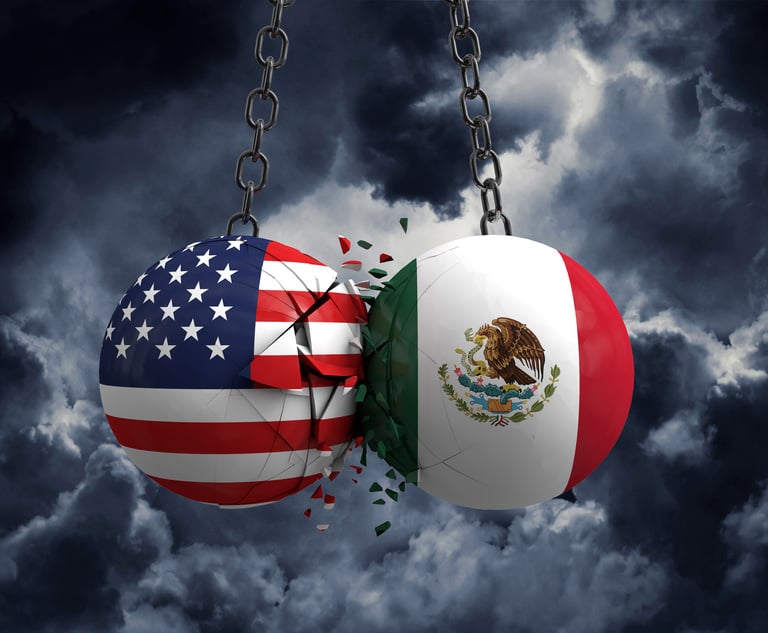Trade highways: how lawyers will gain from the Trans-Pacific Partnership
Lawyers believe the recently signed trade agreement between 12 Pacific Rim countries will have a significant impact on work flow in the region
January 19, 2016 at 08:03 PM
22 minute read
The original version of this story was published on Law.com
Signed at the end of last year after protracted negotiations, the Trans-Pacific Partnership (TPP), has been heralded by US President Barack Obama as the "most progressive trade agreement in history".
And while there has been controversy along the route to signing, lawyers are agreed that the trade agreement between 12 Pacific Rim countries holds huge opportunities for law firms and their clients as well as the region generally.
"If the TPP achieves its objectives it will increase capital flows, trade and foreign investment between member states," says Clifford Chance counsel, Sam Luttrell (pictured below). "That will increase economic activity generally which in turn flows to professional services industries and lawyers specifically."
Others go further, arguing that it is more than just a trade agreement and that it amounts to an 'economic institution' governing all of the rules by which trade occurs in the region. In this instance it should have a far greater impact on lawyers; affecting practices including environmental law, labour law and intellectual property.
Lawyers will have to make sure they are across all of the detail of the agreement and its potential ramifications for clients, argues Herbert Smith Freehills Sydney partner Donald Robertson who is heading the firm's multi-country TPP team.
"The real complexity is working out the relationship between the chapters," he says. "There are exceptions, qualifications and footnotes so we are all working out what the impact is and what it means."
The situation for clients, and their legal advisers, is further complicated by the introduction of future trade agreements which are expected to be completed in within the next five years. The most notable being the ASEAN regional economic partnership which, unlike the TPP, will include China.
The world is getting smaller and more interconnected and everyone is trying to take advantage of that
Robertson notes that the pace of change in the region has accelerated; with the aim of an Asia-Pacific economic area by 2020 there will "suddenly" be a number of interlocking bilateral agreements.
Furthermore the TPP is expected to work alongside China's ambitious One Belt One Road (OBOR) policy. OBOR is designed to make it easier for Chinese companies to invest abroad with a focus on equipping countries with the infrastructure needed to engage with a multi-lateral trade system. The government has created a $50bn Silk Road fund to back the policy.
As a result of OBOR, law firms are expecting greater engagement from Chinese clients looking to invest capital outwards while companies outside of China are seeing the policy as an opportunity to cooperate with Chinese companies.
This in some respects is in contrast to the expected effects of the TPP which is aimed at helping investments from small to medium sized business, says Luttrell.
With the TPP expected to result in many industries becoming more regionally focused, there is a question over whether the legal industry could follow suit with the establishment of larger pan-regional operations, building on moves by many jurisdictions towards liberalising their markets in recent years.
DLA Piper energy and resources lawyer, Matthew Davis comments (pictured right): "The TPP stretches right across the Pacific and OBOR across Asia, Africa and into Europe. Although they have some common areas, in general they reach very different geographical areas and DLA Piper has a good spread of offices across both."
Luttrell suggests that the value to clients will be firms' on-the ground knowledge of how agreements will operate, including compliance issues and disagreements with other member states.
"The annexes to the TPP are expansive and knowing how they operate is something you need to have an ear to the ground to know," he says.
Others are contemplating grouping expertise into a dedicated TPP group covering a wide range of disciplines. Eugene Lim, a tax partner at Baker & McKenzie Singapore, says he expects the TPP to be a treaty which requires law firms to put in place a dedicated TPP practice within the next 10 years. The firm currently has a TPP working group bringing together lawyers from across its network.
Clients are saying 'fantastic, let's take advantage of that' but what they probably don't fully appreciate is all the other regulations
Ultimately the impact of the TPP and OBOR policy on law firms will be driven by clients and their aspirations but given the complexities of the TPP, lawyers may have to help their clients understand what the opportunities are before even starting to advise.
"Clients know this is happening and they are saying 'fantastic, let's take advantage of that' but what they probably don't fully appreciate is all the other regulations," concludes Robertson.
"Everyone understands that the world is getting smaller and more interconnected and everyone is trying to take advantage of that."
Signed at the end of last year after protracted negotiations, the Trans-Pacific Partnership (TPP), has been heralded by US President Barack Obama as the "most progressive trade agreement in history".
And while there has been controversy along the route to signing, lawyers are agreed that the trade agreement between 12 Pacific Rim countries holds huge opportunities for law firms and their clients as well as the region generally.
"If the TPP achieves its objectives it will increase capital flows, trade and foreign investment between member states," says 
Others go further, arguing that it is more than just a trade agreement and that it amounts to an 'economic institution' governing all of the rules by which trade occurs in the region. In this instance it should have a far greater impact on lawyers; affecting practices including environmental law, labour law and intellectual property.
Lawyers will have to make sure they are across all of the detail of the agreement and its potential ramifications for clients, argues
"The real complexity is working out the relationship between the chapters," he says. "There are exceptions, qualifications and footnotes so we are all working out what the impact is and what it means."
The situation for clients, and their legal advisers, is further complicated by the introduction of future trade agreements which are expected to be completed in within the next five years. The most notable being the ASEAN regional economic partnership which, unlike the TPP, will include China.
The world is getting smaller and more interconnected and everyone is trying to take advantage of that
Robertson notes that the pace of change in the region has accelerated; with the aim of an Asia-Pacific economic area by 2020 there will "suddenly" be a number of interlocking bilateral agreements.
Furthermore the TPP is expected to work alongside China's ambitious One Belt One Road (OBOR) policy. OBOR is designed to make it easier for Chinese companies to invest abroad with a focus on equipping countries with the infrastructure needed to engage with a multi-lateral trade system. The government has created a $50bn Silk Road fund to back the policy.
As a result of OBOR, law firms are expecting greater engagement from Chinese clients looking to invest capital outwards while companies outside of China are seeing the policy as an opportunity to cooperate with Chinese companies.
This in some respects is in contrast to the expected effects of the TPP which is aimed at helping investments from small to medium sized business, says Luttrell.
With the TPP expected to result in many industries becoming more regionally focused, there is a question over whether the legal industry could follow suit with the establishment of larger pan-regional operations, building on moves by many jurisdictions towards liberalising their markets in recent years.
Luttrell suggests that the value to clients will be firms' on-the ground knowledge of how agreements will operate, including compliance issues and disagreements with other member states.
"The annexes to the TPP are expansive and knowing how they operate is something you need to have an ear to the ground to know," he says.
Others are contemplating grouping expertise into a dedicated TPP group covering a wide range of disciplines. Eugene Lim, a tax partner at
Clients are saying 'fantastic, let's take advantage of that' but what they probably don't fully appreciate is all the other regulations
Ultimately the impact of the TPP and OBOR policy on law firms will be driven by clients and their aspirations but given the complexities of the TPP, lawyers may have to help their clients understand what the opportunities are before even starting to advise.
"Clients know this is happening and they are saying 'fantastic, let's take advantage of that' but what they probably don't fully appreciate is all the other regulations," concludes Robertson.
"Everyone understands that the world is getting smaller and more interconnected and everyone is trying to take advantage of that."
This content has been archived. It is available through our partners, LexisNexis® and Bloomberg Law.
To view this content, please continue to their sites.
Not a Lexis Subscriber?
Subscribe Now
Not a Bloomberg Law Subscriber?
Subscribe Now
NOT FOR REPRINT
© 2024 ALM Global, LLC, All Rights Reserved. Request academic re-use from www.copyright.com. All other uses, submit a request to [email protected]. For more information visit Asset & Logo Licensing.
You Might Like
View All
Trump and Latin America: Lawyers Brace for Hard-Line Approach to Region

BCLP Mulls Merger Prospects as Profitability Lags, Partnership Shrinks

Trending Stories
Who Got The Work
Michael G. Bongiorno, Andrew Scott Dulberg and Elizabeth E. Driscoll from Wilmer Cutler Pickering Hale and Dorr have stepped in to represent Symbotic Inc., an A.I.-enabled technology platform that focuses on increasing supply chain efficiency, and other defendants in a pending shareholder derivative lawsuit. The case, filed Oct. 2 in Massachusetts District Court by the Brown Law Firm on behalf of Stephen Austen, accuses certain officers and directors of misleading investors in regard to Symbotic's potential for margin growth by failing to disclose that the company was not equipped to timely deploy its systems or manage expenses through project delays. The case, assigned to U.S. District Judge Nathaniel M. Gorton, is 1:24-cv-12522, Austen v. Cohen et al.
Who Got The Work
Edmund Polubinski and Marie Killmond of Davis Polk & Wardwell have entered appearances for data platform software development company MongoDB and other defendants in a pending shareholder derivative lawsuit. The action, filed Oct. 7 in New York Southern District Court by the Brown Law Firm, accuses the company's directors and/or officers of falsely expressing confidence in the company’s restructuring of its sales incentive plan and downplaying the severity of decreases in its upfront commitments. The case is 1:24-cv-07594, Roy v. Ittycheria et al.
Who Got The Work
Amy O. Bruchs and Kurt F. Ellison of Michael Best & Friedrich have entered appearances for Epic Systems Corp. in a pending employment discrimination lawsuit. The suit was filed Sept. 7 in Wisconsin Western District Court by Levine Eisberner LLC and Siri & Glimstad on behalf of a project manager who claims that he was wrongfully terminated after applying for a religious exemption to the defendant's COVID-19 vaccine mandate. The case, assigned to U.S. Magistrate Judge Anita Marie Boor, is 3:24-cv-00630, Secker, Nathan v. Epic Systems Corporation.
Who Got The Work
David X. Sullivan, Thomas J. Finn and Gregory A. Hall from McCarter & English have entered appearances for Sunrun Installation Services in a pending civil rights lawsuit. The complaint was filed Sept. 4 in Connecticut District Court by attorney Robert M. Berke on behalf of former employee George Edward Steins, who was arrested and charged with employing an unregistered home improvement salesperson. The complaint alleges that had Sunrun informed the Connecticut Department of Consumer Protection that the plaintiff's employment had ended in 2017 and that he no longer held Sunrun's home improvement contractor license, he would not have been hit with charges, which were dismissed in May 2024. The case, assigned to U.S. District Judge Jeffrey A. Meyer, is 3:24-cv-01423, Steins v. Sunrun, Inc. et al.
Who Got The Work
Greenberg Traurig shareholder Joshua L. Raskin has entered an appearance for boohoo.com UK Ltd. in a pending patent infringement lawsuit. The suit, filed Sept. 3 in Texas Eastern District Court by Rozier Hardt McDonough on behalf of Alto Dynamics, asserts five patents related to an online shopping platform. The case, assigned to U.S. District Judge Rodney Gilstrap, is 2:24-cv-00719, Alto Dynamics, LLC v. boohoo.com UK Limited.
Featured Firms
Law Offices of Gary Martin Hays & Associates, P.C.
(470) 294-1674
Law Offices of Mark E. Salomone
(857) 444-6468
Smith & Hassler
(713) 739-1250










